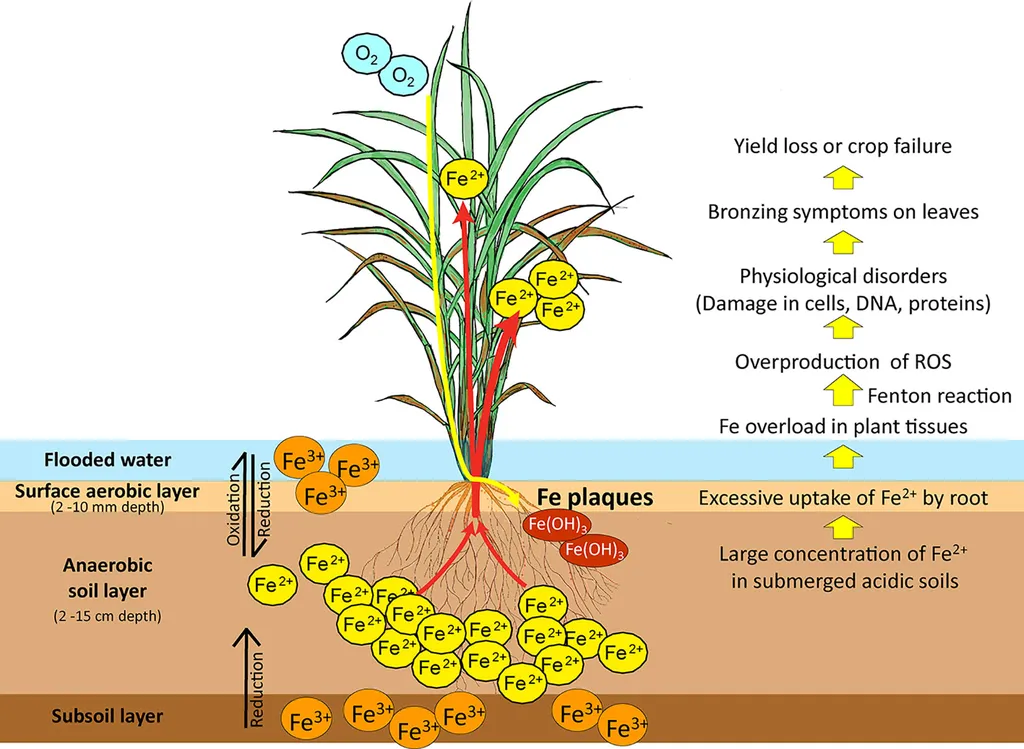In the heart of agricultural innovation, a recent study published in *Geoderma* has shed light on the intricate dance of iron and sulfur in paddy soils, offering new insights into managing cadmium (Cd) and arsenic (As) contamination. Led by Yuepeng Yin from the State Key Laboratory of Soil & Sustainable Agriculture at the Chinese Academy of Sciences, the research delves into the biogeochemical processes that could revolutionize how we approach heavy metal pollution in rice farming.
The study, conducted through pot experiments, explored the combined effects of iron (Fe) and sulfur (S) reduction on Cd and As dynamics in paddy soil-rice systems. Traditional remediation techniques have focused on either Fe or S individually, but this research takes a bold step forward by examining their combined impact. The findings are nothing short of intriguing.
“Unexpectedly, the Fe-S reduction technique had a contrary influence on the migration behavior of Cd and As,” Yin explains. The Fe-S coupling reduction resulted in a synergistic remediation effect, reducing Cd accumulation more effectively than either method alone. This was attributed to the formation of FeS and the stabilization of amorphous iron oxides, which enhanced Cd immobilization.
However, the story takes a twist when it comes to arsenic. Sulfur-induced arsenic reduction exhibited a double-edged effect. While it decreased total soluble As through sulfide formation, it also facilitated the biotransformation and mobilization of methylarsenic species in pore water. This led to an increase in dimethylarsinic acid (DMA) accumulation in rice grains. “Sulfate addition resulted in a 120% increase in DMA facilitated by sulfate reduction,” Yin notes, highlighting the complex interplay between these elements.
The commercial implications of this research are profound. Rice is a staple crop for billions of people, and heavy metal contamination poses a significant threat to food safety and agricultural sustainability. The findings suggest that selective Fe and S remediation strategies could be tailored to specific pollution scenarios, offering a more targeted and effective approach to managing Cd and As in paddy soils.
Moreover, the study underscores the importance of understanding the biogeochemical cycling of these elements. “Fe-S biogeochemistry and cycling have inconsistent effects on the migration of Cd/As,” Yin states, emphasizing the need for nuanced strategies in heavy metal remediation.
As the agricultural sector grapples with the challenges of heavy metal pollution, this research provides a beacon of hope. By harnessing the power of Fe-S coupling, farmers and agronomists can develop more effective remediation techniques, ensuring the safety and sustainability of rice production. The study not only advances our scientific understanding but also paves the way for innovative solutions that can be implemented on a commercial scale.
In the ever-evolving landscape of agritech, this research stands as a testament to the power of interdisciplinary collaboration and the potential of biogeochemical insights to drive agricultural innovation. As we look to the future, the findings from this study will undoubtedly shape the development of new remediation strategies, ensuring a safer and more sustainable future for rice farming.

